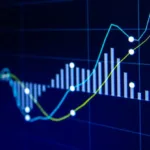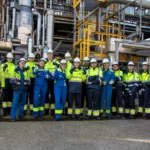A
Accident at work:
Discrete occurrence in the course of work which leads to physical or mental harm. The data include only fatal & non-fatal accidents involving more than 3 calendar days of absence from work. If the accident does not lead to the death of the victim, it is called a ‘non-fatal’ or (‘serious’) accident. (source: Eurostat)
Alternative (low-carbon) feedstock:
Alternative feedstock is any feedstock which replaces primary fossil carbon as feedstock for manufacturing processes in the chemical industry.
Ammonia (NH3):
Ammonia is a colorless gas with a distinct pungent smell and causes irritation of the eyes, nose, throat and respiratory tract. Most of the ammonia produced by industry is used in agriculture as fertilizer. Ammonia is also used as a refrigerant gas, for purification of water supplies, and in the manufacture of plastics, explosives, textiles, pesticides, dyes and other chemicals.
B
Best available technologies (BAT):
Technologies that are approved by legislators or regulators for meeting output standards for a particular process (“best in class”), such as pollution abatement, energy and production efficiency.
Bio(based) economy:
A bioeconomy means using renewable biological resources from land and sea, like crops, forests, fish, animals and micro-organisms to produce food, materials and energy. (source: EU)
Bio-society:
In a bio-society, informed citizens choose a sustainable way of life, supporting an economy that couples economic growth with societal well-being and respect for the environment .
C – D
Carbon dioxide (CO2):
Carbon dioxide is a colorless gas formed during the combustion of any material containing carbon and an important greenhouse gas. Naturally, it makes up 0.04% of the air in the atmosphere. CO2 remains in the climate system for a very long time: CO2 emissions cause increases in atmospheric concentrations of CO2 that will last thousands of years.
Carbon sink:
A carbon sink is any reservoir, natural or otherwise, that accumulates and stores some carbon-containing compound for an indefinite period and thereby lowers the concentration of carbon dioxide (CO2) from to atmosphere.
Cefic Chemdata International:
This is a Cefic database managed jointly with VCI (the German chemical association). The sources of Chemdata are public and mainly come from national chemical associations.
Chemical Oxygen Demand (COD):
The amount of dissolved oxygen needed to oxidise chemical organic materials in water. COD is used as an indicator for the short-term impact of wastewater effluents on the oxygen levels of receiving water.
Chemicals Strategy for Sustainability:
The EU’s chemicals strategy for sustainability towards a toxic-free environment. Chemicals are essential for the well-being, high living standards and comfort of modern society. They are used in many sectors, including health, energy, mobility and housing. However, most chemicals have hazardous properties which can harm the environment and human health. The EU already has sophisticated chemicals laws in place, but global chemicals production is expected to double by 2030. The already widespread use of chemicals will also increase, including in consumer products. The European Commission published a chemicals strategy for sustainability on 14 October 2020. It is part of the EU’s zero pollution ambition, which is a key commitment of the European Green Deal.
Circular Economy Action Plan (CEAP):
This is a plan adopted by the European Commissions in March 2020 and is one of the building blocks of the European Green deal and the EU’s new agenda for sustainable growth. The objective is to facilitate the transition towards a circular economy, which will reduce pressure on natural resources and grate sustainable growth & jobs. It is also a requisite to achieve the EU’s 2050 climate neutrality target and to halt biodiversity loss.
Circular Economy:
A systems approach involving industrial processes and economic activities along the whole value chain that are restorative or regenerative by design, aiming for a climate-neutral and resource-efficient economy by maintaining the value of products, materials and resources as long as possible.
Climate neutral:
Having a balance between GHG emissions, reductions and offsetting through credible carbon credits. Climate neutrality is an intermediate, temporary step in the journey to achieve net- zero. Note that offsetting does not replace the need to reduce emissions in parallel. (source: UNFCCT)
Disposal of waste:
The following activities are viewed as disposal operations; Landfill, land treatment, deep injection, surface impoundment, specially engineered landfill, release into a water body, biological treatment, physico-chemical treatment, incineration, permanent storage, blending or mixing. (source: European Commission)
E
Energy efficiency:
‘Energy efficiency’ means the ratio of output of performance, service, goods or energy, to input of energy. (source: EU Energy Efficiency Directive)
Energy intensity:
The energy intensity shows how much energy is needed per unit of activity, output, or any other organization-specific metric. The production index of the chemical sector is used as the organization-specific production metric.
EU Bioeconomy Monitoring System:
The EU Bioeconomy Monitoring System offers a comprehensive overview of European trends in indicators related to the EU Bioeconomy.
European Green Deal:
A set of policy initiatives by the European commission to transform the EU into a modern, resource-efficient and competitive economy, ensuring:
– no net emissions of greenhouse gases by 2050
– economic growth decoupled from resource use
– no person and no place left behind
European Pollutant Release & Transfer Register (E-PRTR):
The European Pollutant Release and Transfer Register (E-PRTR) is the Europe-wide register that provides easily accessible key environmental data from industrial facilities in European Union Member States. The E-PRTR also covers Iceland, Liechtenstein, Norway, Switzerland, Serbia and the UK. The register contains data reported annually by some 30,000 industrial facilities covering 65 economic activities across Europe.
Eurostat:
Eurostat is the Statistical office of the EU within the European Commission, and its mission is to provide high quality statistics for Europe. It offers a whole range of important and interesting data that governments, businesses, the education sector, journalists and the public can use for their work and daily life.
F
Fatal accident at work:
An accident which leads to the death of a victim within one year of the accident. (source: Eurostat)
Feedstock:
A feedstock is any (unprocessed) material used to supply a manufacturing process. Feedstock can both be a material that is used has been transformed for marketing in large volumes f.e. to support a large-scale chemical reaction, but also a material that can be used as a fuel converted into for energy purposesof fuel. Examples are crude oil, biomass, (renewable) electricity, hydrogen, coal etc.
Fluorinated gases (F-gases):
These are man-made gases that can stay in the atmosphere for centuries and contribute to a global greenhouse effect. There are four types: hydrofluorocarbons (HFCs), perfluorocarbons (PFCs), sulfur hexafluoride (SF6) and nitrogen trifluoride (NF3). F-gases are often used as substitutes for ozone-depleting substances, because they do not damage the atmospheric ozone layer. However, F-gases are powerful greenhouse gases, with a global warming effect up to 23 000 times greater than carbon dioxide (CO2). The revised F-gas Regulation adopted on 1 January 2015 introduced a gradual phase down to help reducing emission emissions to the environment by 2/3 compared with 2015 levels by 2030.
G – K
GHG emissions:
Emissions of greenhouse gases, such as carbon dioxide, nitrous oxide, methane and fluorinated gases, which absorb infrared radiation contributing to the greenhouse effect.
Industrial symbiosis:
Industrial symbiosis is the process by which wastes or by‐products of an industry or industrial process become the raw materials for another. Application of this concept allows materials to be used in a more sustainable way and contributes to the creation of a circular economy.
Key industry activities:
Actions which can be taken in each of the four areas defined in Cefic’s Sustainability charter (Create, Conserve, Connect and Care) to contribute to a safe, resource efficient and circular economy within a climate-neutral Europe – the central objectives of the Green Deal and critical to meet the Sustainable Development Goals (SDGs) set in the UN Global Agenda 2030.
L – N
Low-carbon:
Low carbon technologies, feedstock or economies are based on energy and/or feedstock sources that produce low levels of greenhouse gas (GHG) emissions. When referring to low-carbon technologies, these are technologies that emit low levels of CO2 emissions, or no net CO2 emissions than conventional ones. Some of these technologies make use of alternative energy sources and/or feedstock sources like renewable energy, biomass, or recycled plastics.
Methane (CH4):
Methane is the main constituent of natural gas and emitted during the production and transport of coal, natural gas, and oil. Methane emissions also result from livestock and other agricultural practices, land use and by the decay of organic waste in municipal solid waste landfills. Methane (CH4) is a 28 to 36 more powerful greenhouse gas than CO2, but lasts about a decade in the atmosphere.
Net-zero:
Net-zero refers to a state in which the greenhouse gases going into the atmosphere are balanced by removal out of the atmosphere. The Paris Agreement underlines the need for net zero, requiring states to ‘achieve a balance between anthropogenic emissions by sources and removals by sinks of greenhouse gases in the second half of this century’.
Nitrogen oxides (NOx):
Nitrogen oxides refers to nitric oxide gas (NO) and nitrogen dioxide gas (NO2) and many other gaseous oxides containing nitrogen. The main source of these gases in urban areas are motor vehicle exhaust and indoor gas stoves and kerosene heaters. (Source: EEA)
Nitrous oxide (N2O):
Nitrous oxide, more commonly known as “laughing gas,” is a potent greenhouse gas, 300 times more powerful than carbon dioxide and with a lifetime of an average of 110 years. The main anthropogenic source of N2O is agriculture, but important contributions also come from sewage treatment, fossil fuel combustion, and chemical industrial processes, such as the production of adipic acid and nitric acid. N2O is also produced naturally from a wide variety of biological sources in soil and water, particularly microbial action in wet tropical forests.
NMVOC:
Non-methane volatile organic compounds: Volatile (gas form) organic (containing one or more carbon and hydrogen atoms) compounds that under normal conditions can vaporize and enter the atmosphere, excluding methane gas. NMVOCs are mainly emitted from transportation, industrial processes and use of organic solvents.
P – R
Paris agreement:
The Paris Agreement is a legally binding international treaty on climate change. It was adopted by 196 Parties at COP 21 in Paris, on 12 December 2015 and entered into force on 4 November 2016. Its goal is to limit global warming to well below 2, preferably to 1.5 degrees Celsius, compared to pre-industrial levels. To achieve this long-term temperature goal, countries aim to reach global peaking of greenhouse gas emissions as soon as possible to achieve a climate neutral world by 2050.
Production index:
The production index is a business cycle indicator which aims to measure changes in value added at factor cost of industry and construction over a given reference period. It does this by measuring changes in the volume of output and activity at close and regular intervals, usually monthly.
R&I capital spending:
R&I capital input or gross investment in tangible goods is defined as investment during the reference period in all tangible goods related to research and innovation. Included are new and existing tangible capital goods, whether bought from third parties or produced for own use (i.e. Capitalised production of tangible capital goods), having a useful life of more than one year including non-produced tangible goods such as land. Investments in intangible and financial assets are excluded.
Recovery of waste:
The following activities are viewed as recovery operations; use principally as a fuel or other means to generate energy, solvent reclamation/regeneration, recycling/reclamation of organic substances which are not used as solvents (incl. composting & other biological transformation process), recycling/reclamation of metals & metal compounds, other inorganic compounds, regeneration of acids or bases, recovery of components used for pollution abatement and components from catalysts, oil re-refining or other reuses of oil, land treatment resulting in benefit to agriculture of ecological improvement. (source: European Commission)
Responsible Care:
Responsible Care is the global chemical industry’s voluntary initiative to drive continuous improvement in safe chemical management and achieve excellence in environmental, health, safety and security performance. The initiative is implemented across 62 chemical associations and nearly 70 economies around the world, with almost 600 CEOs pledging a common commitment to global implementation.
S
Safe and Sustainable by Design (SSbD):
As part of the European Green deal, the European commission wants to strive to move towards an economy and society with zero pollution/toxic-free ambition. The objective is for chemicals, materials and products to be designed, produced, and used in a way which does not harm people and the environment.
Scope 1 GHG emissions:
are direct greenhouse gas emissions that are from sources owned or controlled by the reporting entity (f.e. a chemical company). (source: IPCC)
They can be divided into two types of emission sources:
• emissions resulting from on-site combustion of fuels to generate energy
• emissions directly from production processes
Scope 1 GHG emission index:
Indicates the change in GHG emitted by the chemical industry per year compared to a fixed year (f.e. 1990)
Scope 2 GHG emissions:
Emissions of GHG associated with the production of electricity, heat or steam purchased by the reporting entity (source: IPCC).
Scope 3 GHG emissions:
Cover all other indirect emissions, i.e. emissions associated with the extraction and production of purchased materials, fuels, and services, including transport in vehicles not owned or controlled by the reporting entity, outsourced activities, waste disposal, etc. (source: IPCC)
Sulphur oxides (SOx):
Sulfur oxides are a group of highly reactive gases that include SO2, SO3, and solid sulfates. Sulfur oxides are pollutants that contribute to the formation of acid rain, as well as particulate pollution. Volcanoes are a natural source of sulfur oxides in the atmosphere, but 99% of the sulfur dioxide in the atmosphere comes from human activity, such as burning coal, oil, and gas to make electricity and heat. When coal and oil burn, the sulfur in them combines with oxygen in the air to make sulfur oxides. Processing mineral ores that contain sulfur and industrial burning of fossil fuels are also sources of sulfur oxides in the atmosphere.
Sustainable Development Goals (SDGs):
The SDGs or Global Goals were adopted by the United Nations in 2015 as a universal call to action to end poverty, protect the planet, and ensure that by 2030 all people enjoy peace and prosperity. The 17 SDGs are integrated – they recognise that action in one area will affect outcomes in others. Development must balance social, economic and environmental sustainability.
Sustainable Development Indicators (SDIs):
indicators that map performance of the European chemical sector in sustainable growth and development.
T – Z
Turnover:
Comprises the totals invoiced by the observation unit during the reference period, and this corresponds to market sales of goods or services supplied to third parties; it includes all duties and taxes on the goods or services invoiced by the unit with the exception of the VAT invoiced by the unit to its customer and other similar deductible taxes directly linked to turnover; it also includes all other charges (transport, packaging, etc.) passed on to the customer. Price reductions, rebates and discounts as well as the value of returned packing must be deducted.
UN Global Agenda:
The 2030 Agenda for Sustainable Development seeks to eradicate poverty and heal and secure our planet and is a plan for people, planet and prosperity. The 17 Sustainable Development Goals are demonstrating the scale and ambition of this Agenda.
Value added:
The value added at factor costs is the gross income from operating activities after adjusting for operating subsidies and indirect taxes. Value adjustments (such as depreciation) are not subtracted.
Waste hierarchy system:
The EU Waste Framework Directive defines a ‘hierarchy‘ to be applied by EU Member States in waste management. This hierarchy is also known as Lansink’s Ladder. Waste prevention and re-use are the most preferred options, followed by recycling (including composting), then energy recovery, while waste disposal through landfills should be the very last resort.













